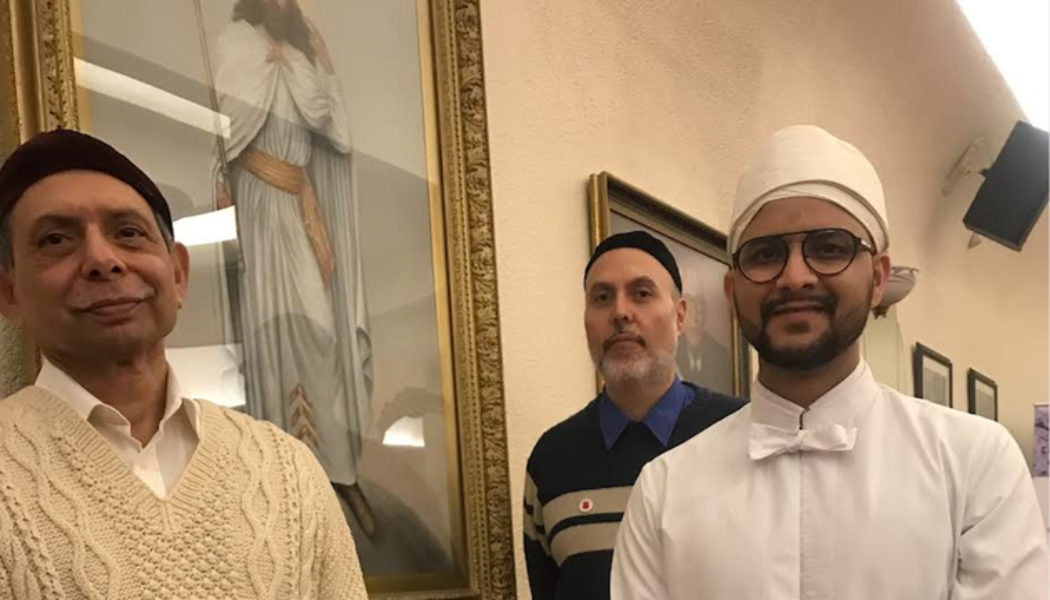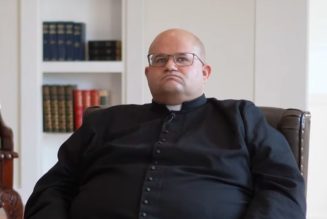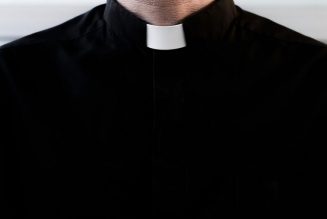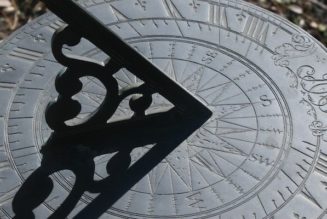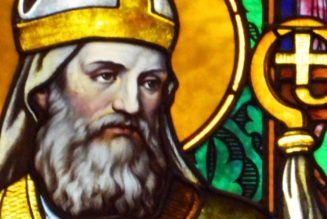
LONDON — It is a cold, dark, wet Sunday night in suburban London.
Having walked through the rain, I am now sitting in a former art deco 1930s movie theater. Before me, there are three masked figures. Dressed all in white robes, they sit on chairs upon a stage. Before them burns a wooden fire in a large brazier.
Above the white-robed figures there is a sign with a threefold imperative: “Good Words, Good Thoughts, Good Deeds.” In seats beside me, watching intently the proceedings, are approximately two dozen people. The heads of all are covered — the men with caps, the women with something resembling white mantillas.
These are Zoroastrians.
One of the oldest religions in the world, Zoroastrianism uses this suburban former movie theater as its only European place of worship.
On my arrival at the London Zoroastrian Centre, the staff could not have been more welcoming or friendly, if perhaps a little bemused as to why a Catholic journalist should brave the elements to attend their ceremony. On contacting the center, I had explained that my interest in their faith and the purpose of visiting was not simply to discuss theology but to explore their perspective on what the Christian world celebrates each Jan. 6 — namely, the pilgrimage and subsequent adoration of the Christ Child by the Magi, as recounted in St. Matthew’s Gospel.
It is widely thought that the Magi were Zoroastrians who had traveled from Persia to the then-Roman-occupied Judea to venerate a new “king.” Their journeying was not simply to discover another monarch, however. Inspired by astrology, the Magi’s search would become a mystical search — ultimately, an Epiphany.
Making my own journey to the Zoroastrians domiciled here in London, I was wondering what they made of that story. Did they recognize themselves in it? And, if so, what significance did it hold for them?
The service I observed had been outlined to me by email before my arrival and described as one of “thanksgiving.” It lasted for one hour. Two Zoroastrian priests and a helper participated in it by the recitation of prayers (in Avestan, an umbrella term for two Old Iranian languages) while the fire before them burned and incense was sprinkled.
The congregation was mostly elderly, with a parent and his young children also in attendance. Some followed the prayers from prayer books while the priests intoned their prayers. Others sat with heads bowed. There was a silence and solemnity to the proceedings that were in contrast to the building we found ourselves in that night.
The giant theater housing the Zoroastrian Centre for London was built in 1936, when movies were one of the most popular forms of mass entertainment. Millions flocked to such theaters across the United Kingdom. The fashionable art deco elegance of the building conveyed the confidence that the building’s owners held, namely, that movies would always be popular with the public at the box office.
In time, television surpassed movies as popular entertainment; these “movie cathedrals” eventually fell into disuse. This was the state of play when, in 2000, the Zoroastrian community bought and began renovating the building, turning it into a place of worship. Built of brick and stone, the building has a curious history that juxtaposes the ancient and the modern, the mystical East and the mercantile West, while at the same time telling the tale of the religion now practiced there and its displacement from the land of its origin.
Zoroastrianism is the ancient religion of modern-day Iran. Today, post-Islam, it survives mostly in India, where the descendants of Zoroastrian Iranian immigrants are known as Parsis, or Parsees. The religion takes its name from the Persian religious reformer Zarathustra (Zoroaster), who lived in the sixth century B.C. Traditionally, he is regarded as the founder of a religion that, to Catholic eyes at least, appears to contain both monotheistic and dualistic elements.
Yet some of the Zoroastrian theological concepts that are shared, at least in name, with Catholicism, are striking: belief in one supreme, loving God; individual judgment; heaven and hell; and awaiting the coming of a “Messiah” — all combined with concepts of resurrection, a final judgment and life everlasting.
Zoroastrianism is not a missionary religion; it is not possible to become a Zoroastrian. Inevitably, as a result, there is a concern that, never numerically many, its adherents will gradually decline to the point of extinction. A 2012 global study estimated that the number of Zoroastrians was only 120,000 worldwide. The majority of these reside in India; after that, the greatest numbers are found in Iran and the United States.
The first recorded arrival of a Zoroastrian in the U.K. was in 1724. However, their numbers have never been many there. It is estimated that, in 1861, there were around 50 Zoroastrians in Britain; by the end of the Second World War, that number had increased to around 200. In the last 50 years, there has been an increase in the number due to immigration from India and Pakistan, as well as other former British colonies; among these immigrants was the family of the rock star Freddie Mercury. In recent years, since the Islamic revolution in 1979, there have been arrivals from the religion’s ancient homeland, Iran. Today, the U.K. is home to approximately 5,000 Zoroastrians.
The only Zoroastrian priest in England is Ervad-Yazad T. Bahadha. Originally from India, he now serves the Zoroastrian community here in the U.K. His training to become a priest took place in India and lasted about eight years. He speaks in pastoral terms of his ministry to the small community of Zoroastrians here in the U.K., whom he considers “a privilege to serve.”
When asked about the Magi story in the Gospel, he says he is, of course, familiar with it. Indeed, perhaps, he suggests he has more insight into it than most as he is, in fact, a Magus.
All Zoroastrian priests come from priestly families. Therefore, Bahadha’s ancestors were all part of the priestly caste that produces Zoroastrian priests, or Magi. He recognizes the Magi’s key elements of the Gospel story as taken from the world of Zoroastrianism, such as gold, frankincense and myrrh, all “easily brought” from Persia, he suggests.
Mahar Godrej Ardeshir is an elder of the London community and is more than willing to discuss his religion. “There will be a coming of the Savior,” he says. The statement initially shocks, so unexpected is it as an expression of this particular hope in a non-Christian place of worship. But, as he makes clear, the concept of a coming Savior has always been part of the belief system of Zoroastrianism.
Less unexpectedly, Zoroastrians hold to the belief that when this Messiah comes then all creation shall be made anew. The role of fire in his religion is, he explains, a material metaphor for God. And, yes, he is familiar with how Christians use similar imagery when speaking of the Holy Spirit. He also speaks to me about the need to pray for “the living and the departed.” Meeting, as we are, in November, a month in which Catholics particularly pray for the dead, this is intriguing.
In charge of the running of the London Centre is Malcolm Deboo. Another community elder, he speaks with an authority and knowledge of his religion and its impact upon the wider world. Conscious of the similarities and links of his faith to different religions — Judaism, Islam and Christianity — needless to say, he, too, is well aware of St. Matthew’s Magi story. That said, he states: “The story does not appear in Zoroastrian history.”
What he is interested in, he says, is not so much its historical details but its role as part of a broad missionary effort throughout the ancient lands where Zoroastrianism was then a widespread religion. It was, he suggests, a story with a wider audience in mind.
As we talk, he mentions other lesser-known facets of his religion’s traditional beliefs, such as the coming Savior being as a result of a “virgin birth.” The more we talk, the more I become aware of how much our two religions appear to have superficial similarities — and yet how distant the two belief systems still remain. By the end of my visit, I realized how little I knew about this mysterious religion from which the Magi emerged.
The Zoroastrians I met were unfailingly gracious and welcoming.
They were also fully aware of the Magi Christmas story.
They are equally aware of how, soon, Christians in the U.K. will be celebrating unawares aspects of Zoroastrian culture from a story whose essence and meaning Zoroastrians do not accept — namely, that the long-awaited Savior did indeed come and that some of their ancestors were witnesses to this.
